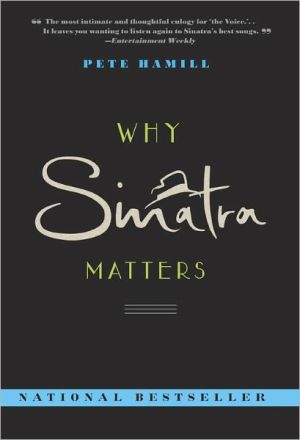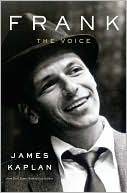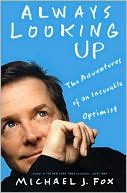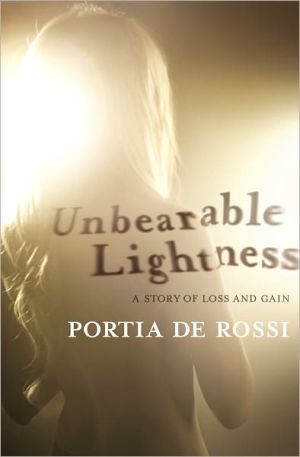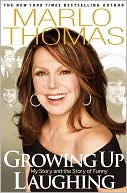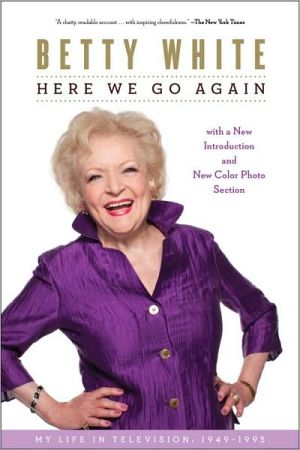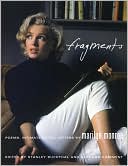Why Sinatra Matters
In this unique tribute, veteran journalist and award winning author Pete Hamill remembers and pays tribute to the legacy of Frank Sinatra. Why Sinatra Matters draws on Hamill's years-long friendship with Sinatra; this is not an impersonal magazine issue full of photos or a quickie bio, but a personal, thoughtful testimony which is sure to pique interest.
Search in google:
We asked Edward Hutchinson, a New York-based freelance writer and devoted Frank Sinatra fan (Hutchinson penned our tribute to Sinatra in December of 1997, on the occasion of the singer's 82nd birthday), to meet with Pete Hamill, author of the appreciation of the Chairman of the Board Why Sinatra Matters. It was a meeting of like minds, and a fertile one at that. Entertainment Weekly - Megan Harlan . . .[T]he most intimate and thoughtful eulogy for 'the Voice' yet. . . .leave[s] you wanting . . .to listen again to Sinatra's best songs.
\ \ \ \ Chapter One\ OVERTURE\ When Frank Sinatra died on the evening of May 14, 1998, the news made the front pages of newspapers all over the world. Many ran extra editions and followed with special supplements. There was little sense of shock; he had been a long time dying. He had also been a long time living, and so the obituaries were full of his life and times.\ It was mandatory to chronicle his wins and losses, his four marriages, his battles, verbal and physical, with reporters and photographers. His romances required many inches of type. There were accounts of his fierce temper, his brutalities, his drunken cruelties. Some described him as a thug or a monster, whose behavior was redeemed only by his talent. We read brief charts of his political odyssey from left to right. The shadow cast upon him by the Mob was also an inevitable part of the stories. And there were tales of his personal generosity to friends and strangers and the millions of dollars he had raised for charities. He was clearly a complicated man.\ "Being an eighteen-karat manic depressive," he was quoted in many of the obituaries, "and having lived a life of violent emotional contradictions, I have perhaps an overacute capacity for sadness and elation."\ But much of the language of farewell had a stale, even hollow quality, probably because most of the obituaries had been ready for too many months. Sinatra had been a virtual recluse since 1995, making only rare public appearances. Over the previous year he had been in and out of hospitals. There were reports from California that he had suffered several heart attacks and, with the possible onset ofAlzheimer's, had difficulty recognizing even old friends. Across those final months there was little hard news about his condition; his children insisted he was fine, although cranky and cantankerous, and so the vacuum was filled with rumor and supposition. The truth was probably a simple one. Frank Sinatra, after a life in which too many cigarettes and too much whiskey were part of the deal, was old; and as happens to all of us when we grow old, the parts just broke down. He had abused his body in a way that was special to his generation of American men; that he had survived until eighty-two was itself a kind of triumph over the odds.\ There were some peculiar components to the television coverage. Most of it was narrated by people from a much younger generation; as they mouthed words about loss and farewell, the tone had an odd insincerity — they could have been discussing someone from the nineteenth century. They were also prisoners of existing visual images. We saw Sinatra at different ages: a very young Sinatra in bow tie and padded shoulders when he was The Voice; a drawn, emaciated Sinatra, flaring at photographers or wearing a thin, pimplike mustache, during his time with Ava Gardner; Sinatra as Maggio in From Here to Eternity and a grinning Sinatra receiving his Academy Award afterward; clips from his television shows, including a bizarre image of Sinatra standing on two chairs, one foot on each, while singing "I've Got the World on a String"; Sinatra with the Rat Pack, horsing around on the stages of Las Vegas; Sinatra with various presidents, from Roosevelt to Reagan; and, of course, endless versions of "My Way."\ It was difficult, reading and watching all of this, to remember why Sinatra mattered to so many people, and why he will continue to matter in the years ahead. The radio did a much better job than print or television, because on radio we heard the music. Not abrupt fragments of songs, not clipped, impatient digests. Late at night, driving through a great city, moving on the dark streets of New York or Paris, Tokyo or London, you could connect more directly to what truly mattered: the music.\ The music was the engine of the life. If there had been no music, there would have been no immense obituaries and no televised farewells. To be sure, Sinatra was one of those figures whose art is often overshadowed by the life. In the end, it is of minor interest that Lord Byron swam the Hellespont, that André Malraux flew in combat during the Spanish Civil War, or that Ernest Hemingway shot lions in Africa. In the end, only the work matters. Sinatra's finest work was making music.\ Sinatra, however, did matter in other ways. He wasn't simply an entertainer from a specific time and place in American life who lived on as a kind of musty artifact. Through a combination of artistic originality, great passion, and immense will, he transcended several eras and indirectly helped change the way all of us lived. He was formed by an America that is long gone: the country of the European immigrants and the virulent America-for- Americans nativism that was directed at them; the country in which a mindless Puritanism, allied with that scapegoating nativism, imposed Prohibition upon the land and helped create the Mob; a country undergoing a vast transformation from a fundamentally rural society to one dominated by cities; a country that passed through Depression and war into the uncertain realities of peace. They were extraordinary times, and in his own way, driven by his own confusions, neuroses, angers, and ambitions, Frank Sinatra helped push the country forward.\ This book is about the accomplishments of Frank Sinatra and why he matters. Some of it is personal, because for a while, I was friendly with Sinatra, talked with him in saloons, in Las Vegas, even for a few days one year in Monte Carlo. At one point he wanted me to write his autobiography; it never happened, for reasons that are no longer important. But in the course of discussing his life, he talked about himself in ways that still had an element of wonder to them; part of him still could not believe that he had become the legend he was. To be sure, we were not friends in any conventional way; I did not visit his home and he did not visit mine. Only a very few intimate friends ever had such access, and I was certainly not one of them. But I liked him enormously.\ He was wonderful with children, including my two daughters. He was funny. He was vulnerable. I never saw the snarling bully of the legend. That Frank Sinatra certainly existed; on the day that his death made all those front pages, there were too many people who remembered only his cruelties. But he never showed that side of himself when I was around. On those nights, I was in the company of an intelligent man, a reader of books, a lover of painting and classical music and sports, gallant with women, graceful with men. Perhaps he was just donning a mask in my company, presenting images to a writer so that they would be remembered by the writer in a certain way: a kind of performance. Or perhaps the snarling bully was the true masked character, a clumsy personal invention, and behind the mask there was simply a young man afraid of the world. Or perhaps, by the time I knew him, he had just grown out of his angers, exhausted them, and settled for what he was and the way he was regarded. I don't know. Like all great artists, Frank Sinatra contained secret places, abiding personal mysteries, endless contradictions. On occasion, a curtain would part, there would be a moment of epiphany, and I could see the uncertain older man who wanted to understand what it all meant, the man who said that dying was a pain in the ass. I liked that man very much.\ This book does not pretend to be the final word on Frank Sinatra. Several full-scale biographies have already been written, each with its attendant excellencies; more are sure to follow. But there were aspects of this man that should be remembered and honored. In Sinatra's time, his fame as a singer spread from his own country to the world. His turbulent personality, often shadowed by notoriety, seemed inseparable from the style and originality of his art and gave him an essential place on the public stage of the American century. Now Sinatra is gone, taking with him all his anger, cruelty, generosity, and personal style. The music remains. In times to come, that music will continue to matter, whatever happens to our evolving popular culture. The world of my grandchildren will not listen to Sinatra in the way four generations of Americans have listened to him. But high art always survives. Long after his death, Charlie Parker still plays his version of the urban blues. Billie Holiday still whispers her anguish. Mozart still erupts in joy. Every day, in cities and towns all over the planet, someone discovers them for the first time and finds in their art that mysterious quality that makes the listener more human. In their work all great artists help transcend the solitude of individuals; they relieve the ache of loneliness; they supply a partial response to the urging of writer E. M. Forster: "Only connect." In their ultimate triumph over the banality of death, such artists continue to matter. So will Frank Sinatra.
\ From Barnes & NoblePete Hamill knew Frank Sinatra well—so well, in fact, that he almost coauthored the singer's autobiography. In preparing for that never-to-be-written volume, Hamill and Sinatra spent many hours discussing the singer's long, successful career, and it is on those conversations that Hamill based the book-length essay that is Why Sinatra Matters.\ \ \ \ \ Christopher Lehmann-HauptIf [Hamill] fails to make you feel the same amount of affection for Sinatra [as he does], he certainly conveys his hero's rough charm. . . .[And] his book does admirably convey why Sinatra's music has been so much a part of the lives of so many generations. . . .his music keeps floating, sustained by memory. — The New York Times\ \ \ Megan Harlan. . .[T]he most intimate and thoughtful eulogy for 'the Voice' yet. . . .leave[s] you wanting . . .to listen again to Sinatra's best songs. \ —Entertainment Weekly\ \ \ \ \ Terry TeachoutA graceful reminiscence of Sinatra. \ —New York Times Book Review\ \ \ \ \ Publishers WeeklyLike a musical Elements of Style, Hamill's slim meditation on Frank Sinatra is confident, smart and seamless. Since (and immediately before) Sinatra's death in May 1998, countless tributes have been made to the singer; Hamill (A Drinking Life) seems to be writing to set the record straight, for he knew Sinatra and, before that, knew the singer's music. But Hamill doesn't fawn over Sinatra the way other, younger writers have recently done. Rather, he elegantly tells the Sinatra story, dwelling on the singer's best recordings, dismissing "the Rat Pack, the swagger, the arrogance, the growing fortune, the courtiers," because in the end, he writes, they are "of little relevance." What matters, according to Hamill, is the music, chiefly that of Sinatra's early mature years, when the singer released his celebrated albums on the Capitol label. Where a starry-eyed author might vaguely praise these albums for their pathos and vulnerability, Hamill points out that, before the singer's Capitol comeback years, Sinatra's fans were almost exclusively young women. The stubborn, post-Ava Gardner heartache of Sinatra's later records, however, with their lack of self-pity, gained Sinatra a chiefly male audience. Of this, perhaps the singer's greatest musical period, Hamill writes that Sinatra "perfected the role of the Tender Tough Guy.... Before him, that archetype did not exist in American popular culture." That may be true, but Hamill sets his book apart from the many others about Old Blue Eyes by tempering intelligent superlatives with the retelling of touching, revelatory moments the two men shared. Hamill's is a definitive introduction to Sinatra's work. (Oct.)\ \ \ \ \ Library JournalThe barrage of recent Frank Sinatra books has resulted in his being the most written-about celebrity in the world after Monroe and Presley. Hamill's slim essay is distinguished from other recent works by its objective focus on the components of the late singer's enduring musical legacy. Veteran writer Hamill (e.g., A Drinking Life, LJ 1/94) is comfortable in the New York City milieu of late nights, saloons, and prizefighters, and he has captured the essence of Sinatra, who created something that was not there before he arrived: an urban American voice. The book's strength is its insight into and evocation of the Italian American immigrant experience that had such a strong influence on Sinatra. Minor weaknesses are an oversimplified examination of prejudice and an underdeveloped 1974 vignette about Ava Gardner that fails to make its point. Recommended for public and academic libraries.--Bruce Henson, Georgia Inst. of Technology, Atlanta\ \ \ \ \ Kirkus ReviewsWhat a perfect match: the world's greatest 'saloon singer' eulogized superbly by the author of The Drinking Life. Hamill knew Sinatra, nearly co-authored the singer's autobiography, and in preparation for that never-to-be-written volume, the duo had many long conversations. But this slender volume, an essay really, is not the collection of revelations and self-justifications that a ghosted autobiography might have been. Rather, it's an unusually thoughtful contribution to the growing body of literature of appreciation of Sinatra as an artist, a supreme interpreter of the great American popular song. Hamill has a good journalist's finely tuned antenna for the Zeitgeist. In his recounting of Sinatra's career (the author limits himself tellingly to the rise to stardom, the disastrous fall in the early '50s and the comeback shortly after), Hamill's antennae get a useful workout. More than almost any other of Sinatra's critics, he understands the centrality of the immigrant experience (both Sinatra's parents were born in Italy), Prohibition, and the Second World War to Sinatra's career and his meaning as an icon. At the same time, Hamill is savvy enough to know what he doesn't know; like any good reporter, he relies on well-chosen expert testimony to fill in the blanks, here mostly in technical matters of music-making. And while Hamill is clearly not an entirely objective observer, a point he addresses with candor, this is anything but a bronzing. The essay touches on Sinatra's failings with frankness (no pun intended), and if the author dismisses the stories about Sinatra's Mob ties a little too quickly to satisfy some carpers, he does so with a deft intelligence that brings usback to the most important point: 'In the end only the work matters. Sinatra's finest work was making music.' Despite its brevity, Why Sinatra Matters belongs in any collection of important books on American popular music of the 20th Century.\ \
